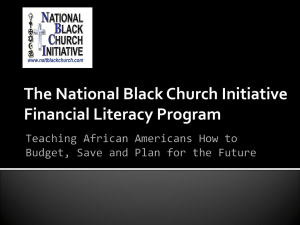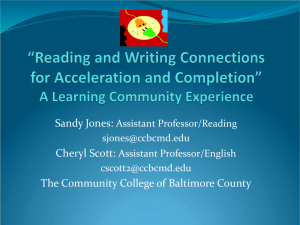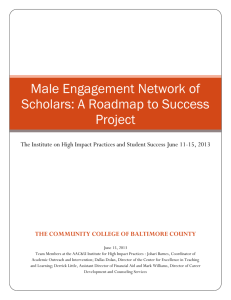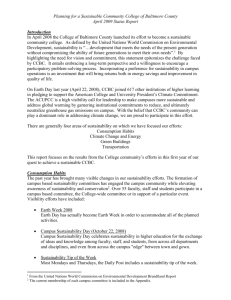Scaling_Up_at_CCBC
advertisement
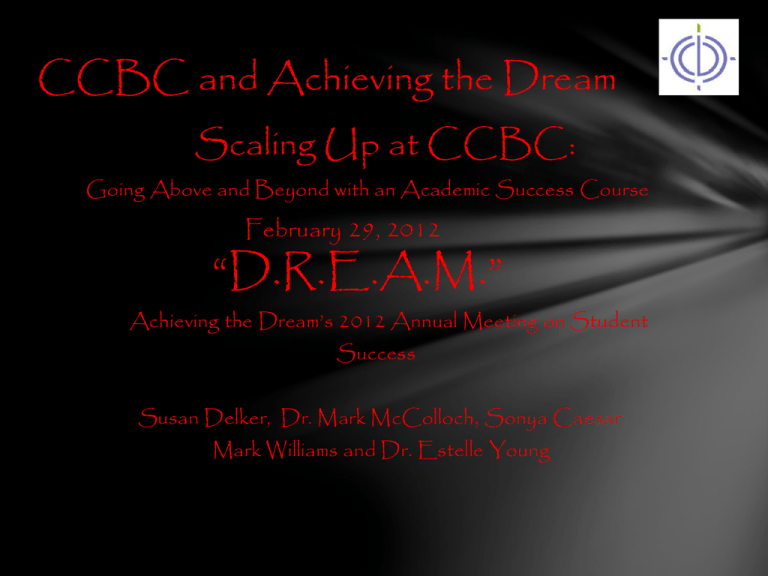
CCBC and Achieving the Dream Scaling Up at CCBC: Going Above and Beyond with an Academic Success Course February 29, 2012 “D.R.E.A.M.” Achieving the Dream’s 2012 Annual Meeting on Student Success Susan Delker, Dr. Mark McColloch, Sonya Caesar Mark Williams and Dr. Estelle Young CCBC = 74,000 Students How to Deliver Student Success Change at Scale No Boutique Programs Pilots Evaluated for Scalability So, Acceleration in Developmental Education Tested and Doubled Each Term Term 1 Term 2 Term 3 Term 4 Comprehensive Academic Advising Group Labs Technology Faculty Role (including ACDV) Close Gap Financial Literacy – reach every student CRT aiming at all faculty What Did We Do- ACDV 101 •ACDV 101 – Academic Development: Transitioning to College •Scalable - the course is required in the first semester for all new full-time and part-time degree-seeking students. •Cost effective- 1 credit; 1.5 contact hours, max class size 22. ACDV Course Overview Major topics include life skills, academic skills, CCBC policies and resources, introduction to career exploration, academic planning, technology skills for learning. Standard grading system; D is passing . Overview Experiential Face-to-Face, Online and Blended Continuous collaboration Original Concept •Four Academies Health Professions Business and Social Sciences Arts and Humanities STEM •Challenges Registration Curriculum College readiness Financial needs Faculty training Program Evaluation Preliminary Outcomes Spring to fall retention Developmental education needs vs College readiness Rates of Completion for African American Students African American/Black students success rate in ACDV 101 was 59% while Caucasian/White students success rate in ACDV 101 was 71%. What We Have Learned? Course Scheduling Course Delivery System What did it mean? Create Academies Increase the number of African American male ACDV sections Infuse Financial Literacy into the curriculum Academies: Why Did We Start? School of Health Professions (SHP) - Need for early and intentional preparation for entry into rigorous health care career tracks Challenge: Developmental Education needs Persistence Existing ACDV curriculum What Was Our Objective? Prepare Freshman for Requirements of SHP Programs Technical reading rigor and volume Employ same study methods as SHP Overall allied health focus Create awareness of various allied health career paths Infuse time management activities What Did We Do? Created: Health academy within ACDV An integrated reading, note-taking, review, and test preparation module Using Anatomy and Physiology textbook Career lattice Career and educational plan/activities Focused time management strand What Have We Learned? Success Rates Time restraints Goal conflict Future integrative opportunities What Does It Mean? Revision and refinement of initial design Potential for growth Financial Literacy: The “Why” An AtD Strategic Strand Faculty Survey Financial Literacy: The Primary “Goals” Create awareness Analyze spending habits Needs vs. Wants Refund checks Implementing a Savings plan Financial Literacy: The “How” ACDV 101 Curriculum Overview Course Design Framework Lesson #1 Transtheoretical Model of Change Lesson #2 Mini Documentary Pre & Post Surveys Feed the Pig Assessment Lesson #3 Micro Savings Class Project Lesson #4 Student Scenarios Financial Literacy: The “Outcomes” Preliminary Data Program Expansion African American Cohort What can be changed through institutional means? Broadening the scope Collaboration and Institutional Student enrollment African American Cohort Strategic foci of course: Cultural differences Content development Responsibility & accountability Increasing persistence Collaborative learning Informal academic experiences Intrusive advising and journaling African American Cohort Maximum participation- Monitoring sections Clean Sections Future Scaling Fall 2011 (all of these were in the first seven weeks) 203 students- 46 % success in the A-C range, 26% failed the course* 9% either withdrew or stopped attending . Fall 2012 scaling to 20 sections African American Cohort Engage adjunct faculty with multiple connections to the College; and base them in a “safe zone” • Student-faculty informal contacts • Teacher behavior - Sustained attention and early interventions • Face to face exposure with instructors • Supportive Leadership • Willingness to evoke change • Suit needs of campus • Instructor training- Involving other faculty/staff to teach and promote the vision Contact Information •Sonya Caesar, Developmental Education Coordinator •Scaesar@ccbcmd.edu 443-840-3455 •Susan Delker, Department Chair, Academic Development Sdelker@ccbcmd.edu 443-840-2004 •Dr. Mark McColloch, Vice President of Instruction •Mmccolloch@ccbcmd.edu •Dr. Estelle Young, Director, School of Health Professions Student Success Support Eyoung2@ccbcmd.edu 443-840-1704 •Mark Williams, Director, Career Development and Counseling Services Mwilliams@ccbcmd.edu 443-840-4334

